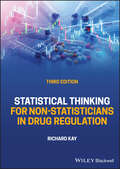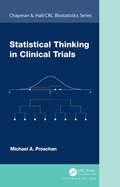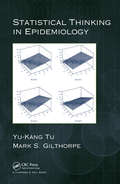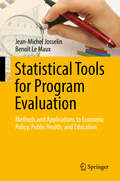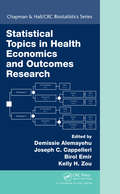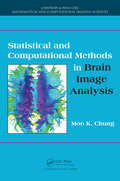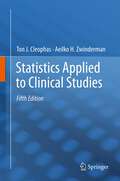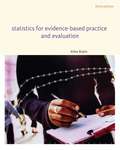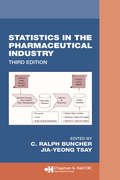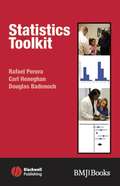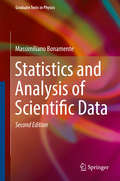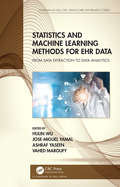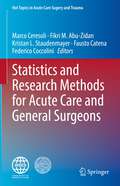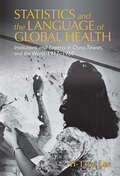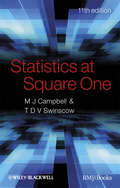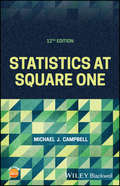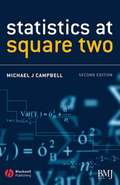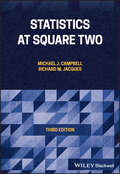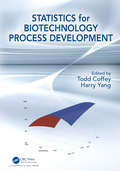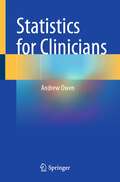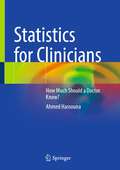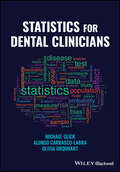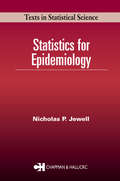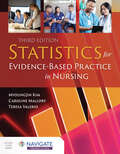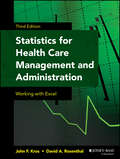- Table View
- List View
Statistical Thinking for Non-Statisticians in Drug Regulation
by Richard KaySTATISTICAL THINKING FOR NON-STATISTICIANS IN DRUG REGULATION Statistical methods in the pharmaceutical industry are accepted as a key element in the design and analysis of clinical studies. Increasingly, the medical and scientific community are aligning with the regulatory authorities and recognizing that correct statistical methodology is essential as the basis for valid conclusions. In order for those correct and robust methods to be successfully employed there needs to be effective communication across disciplines at all stages of the planning, conducting, analyzing and reporting of clinical studies associated with the development and evaluation of new drugs and devices. Statistical Thinking for Non-Statisticians in Drug Regulation provides a comprehensive in-depth guide to statistical methodology for pharmaceutical industry professionals, including physicians, investigators, medical science liaisons, clinical research scientists, medical writers, regulatory personnel, statistical programmers, senior data managers and those working in pharmacovigilance. The author’s years of experience and up-to-date familiarity with pharmaceutical regulations and statistical practice within the wider clinical community make this an essential guide for the those working in and with the industry. The third edition of Statistical Thinking for Non-Statisticians in Drug Regulation includes: A detailed new chapter on Estimands in line with the 2019 Addendum to ICH E9 Major new sections on topics including Combining Hierarchical Testing and Alpha Adjustment, Biosimilars, Restricted Mean Survival Time, Composite Endpoints and Cumulative Incidence Functions, Adjusting for Cross-Over in Oncology, Inverse Propensity Score Weighting, and Network Meta-Analysis Updated coverage of many existing topics to reflect new and revised guidance from regulatory authorities and author experience Statistical Thinking for Non-Statisticians in Drug Regulation is a valuable guide for pharmaceutical and medical device industry professionals, as well as statisticians joining the pharmaceutical industry and students and teachers of drug development.
Statistical Thinking in Clinical Trials (Chapman & Hall/CRC Biostatistics Series)
by Michael A. ProschanStatistical Thinking in Clinical Trials combines a relatively small number of key statistical principles and several instructive clinical trials to gently guide the reader through the statistical thinking needed in clinical trials. Randomization is the cornerstone of clinical trials and randomization-based inference is the cornerstone of this book. Read this book to learn the elegance and simplicity of re-randomization tests as the basis for statistical inference (the analyze as you randomize principle) and see how re-randomization tests can save a trial that required an unplanned, mid-course design change. Other principles enable the reader to quickly and confidently check calculations without relying on computer programs. The `EZ’ principle says that a single sample size formula can be applied to a multitude of statistical tests. The `O minus E except after V’ principle provides a simple estimator of the log odds ratio that is ideally suited for stratified analysis with a binary outcome. The same principle can be used to estimate the log hazard ratio and facilitate stratified analysis in a survival setting. Learn these and other simple techniques that will make you an invaluable clinical trial statistician.
Statistical Thinking in Epidemiology
by Yu-Kang Tu Mark GilthorpeWhile biomedical researchers may be able to follow instructions in the manuals accompanying the statistical software packages, they do not always have sufficient knowledge to choose the appropriate statistical methods and correctly interpret their results. Statistical Thinking in Epidemiology examines common methodological and statistical problems
Statistical Tools for Program Evaluation: Methods and Applications to Economic Policy, Public Health, and Education
by Jean-Michel Josselin Benoît Le MauxThis book provides a self-contained presentation of the statistical tools required for evaluating public programs, as advocated by many governments, the World Bank, the European Union, and the Organization for Economic Cooperation and Development. After introducing the methodological framework of program evaluation, the first chapters are devoted to the collection, elementary description and multivariate analysis of data as well as the estimation of welfare changes. The book then successively presents the tools of ex-ante methods (financial analysis, budget planning, cost-benefit, cost-effectiveness and multi-criteria evaluation) and ex-post methods (benchmarking, experimental and quasi-experimental evaluation). The step-by-step approach and the systematic use of numerical illustrations equip readers to handle the statistics of program evaluation. It not only offers practitioners from public administrations, consultancy firms and nongovernmental organizations the basic tools and advanced techniques used in program assessment, it is also suitable for executive management training, upper undergraduate and graduate courses, as well as for self-study.
Statistical Topics in Health Economics and Outcomes Research (Chapman & Hall/CRC Biostatistics Series)
by Joseph C. Cappelleri Demissie Alemayehu Birol Emir Kelly H. ZouWith ever-rising healthcare costs, evidence generation through Health Economics and Outcomes Research (HEOR) plays an increasingly important role in decision-making about the allocation of resources. Accordingly, it is now customary for health technology assessment and reimbursement agencies to request for HEOR evidence, in addition to data from clinical trials, to inform decisions about patient access to new treatment options. While there is a great deal of literature on HEOR, there is a need for a volume that presents a coherent and unified review of the major issues that arise in application, especially from a statistical perspective. Statistical Topics in Health Economics and Outcomes Research fulfils that need by presenting an overview of the key analytical issues and best practice. Special attention is paid to key assumptions and other salient features of statistical methods customarily used in the area, and appropriate and relatively comprehensive references are made to emerging trends. The content of the book is purposefully designed to be accessible to readers with basic quantitative backgrounds, while providing an in-depth coverage of relatively complex statistical issues. The book will make a very useful reference for researchers in the pharmaceutical industry, academia, and research institutions involved with HEOR studies. The targeted readers may include statisticians, data scientists, epidemiologists, outcomes researchers, health economists, and healthcare policy and decision-makers.
Statistical and Computational Methods in Brain Image Analysis (Chapman & Hall/CRC Mathematical and Computational Imaging Sciences Series)
by Moo K. ChungThe massive amount of nonstandard high-dimensional brain imaging data being generated is often difficult to analyze using current techniques. This challenge in brain image analysis requires new computational approaches and solutions. But none of the research papers or books in the field describe the quantitative techniques with detailed illustratio
Statistics Applied to Clinical Studies
by Aeilko H. Zwinderman Ton J. CleophasThanks to the omnipresent computer, current statistics can include data files of many thousands of values, and can perform any exploratory analysis in less than seconds. This development, however fascinating, generally does not lead to simple results. We should not forget that clinical studies are, mostly, for confirming prior hypotheses based on sound arguments, and the simplest tests provide the best power and are adequate for such studies. In the past few years the authors of this 5th edition, as teachers and research supervisors in academic and top-clinical facilities, have been able to closely observe the latest developments in the field of clinical data analysis, and they have been able to assess their performance. In this 5th edition the 47 chapters of the previous edition have been maintained and upgraded according to the current state of the art, and 20 novel chapters have been added after strict selection of the most valuable and promising novel methods. The novel methods are explained using practical examples and step-by-step analyses readily accessible for non-mathematicians. All of the novel chapters have been internationally published by the authors in peer-reviewed journal, including the American Journal of Therapeutics, the European Journal of Clinical Investigation, The International journal of Clinical Pharmacology and therapeutics, and other journals, and permission is granted by all of them to use this material in the current book. We should add that the authors are well-qualified in their fields of knowledge. Professor Zwinderman is president-elect of the International Society of Biostatistics, and Professor Cleophas is past-president of the American College of Angiology. From their expertise they should be able to make adequate selections of modern methods for clinical data analysis for the benefit of physicians, students, and investigators. The authors, although from a different discipline, one clinician and one statistician, have been working and publishing together for over 10 years, and their research of statistical methodology can be characterized as a continued effort to demonstrate that statistics is not mathematics but rather a discipline at the interface of biology and mathematics. They firmly believe that any reader can benefit from this clinical approach to statistical data analysis.
Statistics For Evidence-Based Practice And Evaluation
by Allen RubinBoth practical and easy to read, Rubin's STATISTICS FOR EVIDENCE-BASED PRACTICE AND EVALUATION provides you with a step-by-step guide that will help you succeed in your course. Practice illustrations and exercises support your ability to study and retain core concepts, while practical examples provide you with the opportunity to see how and when data analysis and statistics are used by helping professionals in the real world.
Statistics In the Pharmaceutical Industry (Chapman & Hall/CRC Biostatistics Series)
by C. Ralph Buncher Jia-Yeong TsayThe growth of the pharmaceutical industry over the past decade is astounding, but the impact of this growth on statistics is somewhat confusing. While software has made analysis easier and more efficient, regulatory bodies now demand deeper and more complex analyses, and pharmacogenetic/genomic studies serve up an entirely new set of challenges. For more than two decades, Statistics in the Pharmaceutical Industry has been the definitive guide to sorting through the challenges in the industry, and this Third Edition continues that tradition.Updated and expanded to reflect the most recent trends and developments in the field, Statistics in the Pharmaceutical Industry, Third Edition presents chapters written by experts from both regulatory agencies and pharmaceutical companies who discuss everything from experimental design to post-marketing studies. This approach sheds light on what regulators consider acceptable methodologies and what methods have proven successful for industrial statisticians. Both new and revised chapters reflect the increasingly global nature of the industry as represented by authors from Japan and Europe, the increasing trend toward non-inferiority/equivalence testing, adaptive design in clinical trials, global harmonization of regulatory standards, and multiple comparison studies. The book also examines the latest considerations in anti-cancer studies. Statistics in the Pharmaceutical Industry, Third Edition demystifies the approval process by combining regulatory and industrial points of view, making it a must-read for anyone performing statistical analysis at any point in the drug approval process.
Statistics Toolkit (EBMT-EBM Toolkit Series #9)
by Douglas Badenoch Carl Heneghan Rafael PereraThis concise book will help you to interpret the statistical evidence provided by quantitative studies and to plan how to work with data in your own clinical research. Following the successful format of the Toolkit series, Statistics Toolkit guides the reader through statistical concepts using flowcharts, diagrams and real life examples to reflect concepts in a simple and practical manner. Sections include: Clear explanation of basic concepts in the context of clinical research Demonstration of how data are described, displayed and interpreted in different formats Practical glossary and key to the symbols used in statistics and a discussion of the software tools The book offers a handy, quick reference that has an easy-to-follow structure throughout, making it ideal for health care professionals and students.
Statistics and Analysis of Scientific Data
by Massimiliano BonamenteThe revised second edition of this textbook provides the reader with a solid foundation in probability theory and statistics as applied to the physical sciences, engineering and related fields. It covers a broad range of numerical and analytical methods that are essential for the correct analysis of scientific data, including probability theory, distribution functions of statistics, fits to two-dimensional data and parameter estimation, Monte Carlo methods and Markov chains. Features new to this edition include: * a discussion of statistical techniques employed in business science, such as multiple regression analysis of multivariate datasets. * a new chapter on the various measures of the mean including logarithmic averages. * new chapters on systematic errors and intrinsic scatter, and on the fitting of data with bivariate errors. * a new case study and additional worked examples. * mathematical derivations and theoretical background material have been appropriately marked, to improve the readability of the text. * end-of-chapter summary boxes, for easy reference. As in the first edition, the main pedagogical method is a theory-then-application approach, where emphasis is placed first on a sound understanding of the underlying theory of a topic, which becomes the basis for an efficient and practical application of the material. The level is appropriate for undergraduates and beginning graduate students, and as a reference for the experienced researcher. Basic calculus is used in some of the derivations, and no previous background in probability and statistics is required. The book includes many numerical tables of data, as well as exercises and examples to aid the readers' understanding of the topic.
Statistics and Machine Learning Methods for EHR Data: From Data Extraction to Data Analytics (Chapman & Hall/CRC Healthcare Informatics Series)
by Hulin Wu Jose-Miguel Yamal Ashraf Yaseen Vahed MaroufyThe use of Electronic Health Records (EHR)/Electronic Medical Records (EMR) data is becoming more prevalent for research. However, analysis of this type of data has many unique complications due to how they are collected, processed and types of questions that can be answered. This book covers many important topics related to using EHR/EMR data for research including data extraction, cleaning, processing, analysis, inference, and predictions based on many years of practical experience of the authors. The book carefully evaluates and compares the standard statistical models and approaches with those of machine learning and deep learning methods and reports the unbiased comparison results for these methods in predicting clinical outcomes based on the EHR data. Key Features: Written based on hands-on experience of contributors from multidisciplinary EHR research projects, which include methods and approaches from statistics, computing, informatics, data science and clinical/epidemiological domains. Documents the detailed experience on EHR data extraction, cleaning and preparation Provides a broad view of statistical approaches and machine learning prediction models to deal with the challenges and limitations of EHR data. Considers the complete cycle of EHR data analysis. The use of EHR/EMR analysis requires close collaborations between statisticians, informaticians, data scientists and clinical/epidemiological investigators. This book reflects that multidisciplinary perspective.
Statistics and Research Methods for Acute Care and General Surgeons (Hot Topics in Acute Care Surgery and Trauma)
by Fausto Catena Federico Coccolini Marco Ceresoli Fikri M. Abu-Zidan Kristan L. StaudenmayerThe main aim of this book is to offer an easy tool to read a scientific article with greater awareness, to understand and evaluate it more thoroughly, and to better plan research. Today, in the era of evidence-based medicine, both research and daily patient-focused clinical practice are no longer possible without a thorough knowledge of the literature and its continuous updates.Written by surgeons for surgeons, this practical book makes the basic concept of statistics and research methodology easy to understand and apply for young surgeons and researchers, students and residents.
Statistics and the Language of Global Health: Institutions and Experts in China, Taiwan, and the World, 1917–1960 (Global Health Histories)
by Yi-Tang LinYi-Tang Lin presents the historical process by which statistics became the language of global health for local and international health organizations. Drawing on archival material from three continents, this study investigates efforts by public health schools, philanthropic foundations, and international organizations to turn numbers into an international language for public health. Lin shows how these initiatives produced an international network of public health experts who, across various socioeconomic and political contexts, opted for different strategies when it came to setting global standards and translating local realities into numbers. Focusing on China and Taiwan between 1917 and 1960, Lin examines the reception, adaptation, and appropriation of international health statistics. She presents the dynamic interplay between numbers, experts, and policy-making in international health organizations and administrations in China and Taiwan. This title is also available as Open Access.
Statistics at Square One
by Michael J. Campbell T. D. SwinscowThe new edition of this international bestseller continues to throw light on the world of statistics for health care professionals and medical students.Revised throughout, the 11th edition features new material in the areas ofrelative risk, absolute risk and numbers needed to treatdiagnostic tests, sensitivity, specificity, ROC curvesfree statistical softwareThe popular self-testing exercises at the end of every chapter are strengthened by the addition of new sections on reading and reporting statistics and formula appreciation.
Statistics at Square One
by Michael J. CampbellSTATISTICS AT SQUARE ONE The new edition of the popular introduction to the world of statistics for health care professionals and medical studentsFirst published nearly three decades ago, Statistics at Square One remains one of the most popular introductions to medical statistics. Now in its twelfth edition, this international bestseller continues to be a must-have resource for anyone in need of a thorough introduction to statistics in the health sciences. Clear and accessible chapters help students with no previous background in the subject understand fundamental topics including summary statistics for quantitative and binary data, diagnostic and screening tests, populations and samples, survival analysis, correlation and regression, study design, computer modeling, and more.This edition reflects contemporary understanding of medical statistics and emphasizes the importance of statistics in public health, including extensively updated coverage of diagnostic tests and new COVID-related examples. All figures and examples now include code to reproduce them in the R statistical software. New chapters cover the basics for understanding numbers and introduce the use of models in medical statistical analysis. Based on the author’s many years of experience teaching medical and health science students, the latest edition of this classic textbook:Highlights the connections between different medical statistics methodsEmphasizes the proper use of p-values in testingFeatures practical examples from recent literatureContains end-of-chapter exercises with answers, some of which are based on the Royal College of General Practitioners (RCGP) Advanced Knowledge TestStatistics at Square One is required reading for all medical and health care practitioners and students wanting to understand the use and value of statistical analysis in the health sciences.
Statistics at Square Two
by Michael J. CampbellUpdated companion volume to the ever popular Statistics at Square One (SS1) Statistics at Square Two, Second Edition, helps you evaluate the many statistical methods in current use. Going beyond the basics of SS1, it covers sophisticated methods and highlights misunderstandings. Easy to read, it includes annotated computer outputs and keeps formulas to a minimum. Worked examples of methods such as multiple and logical regression reinforce the text. Each chapter concludes with exercises to stimulate learning.All those who need to understand statistics in clinical research papers and apply them in their own research will value this compact and coherent guide.
Statistics at Square Two: Understanding Modern Statistical Applications In Medicine
by Michael J. Campbell Richard M. JacquesSTATISTICS AT SQUARE TWO An easy-to-follow exploration of intermediate statistical techniques used in medical research In the newly revised third edition of Statistics at Square Two: Understanding Modern Statistical Applications in Medicine, a team of distinguished statisticians delivers an accessible and intuitive discussion of advanced statistical methods for readers and users of scientific medical literature. This will allow readers to engage critically with modern research as the authors explain the correct interpretation of results in the medical literature. The book includes two brand new chapters covering meta-analysis and time-series analysis as well as new references to the many checklists that have appeared in recent years to enable better reporting of contemporary research. Most examples have been updated as well, and each chapter contains practice exercises and answers. Readers will also find sample code (in R) for many of the analyses, in addition to: A thorough introduction to models and data, including the different types of data, statistical models, and computer-intensive methods Comprehensive explorations of multiple linear regression, including the interpretation of computer output, diagnostic statistics such as influential points, and many uses of multiple regression Practical discussions of multiple logistic regression, survival analysis, Poisson regression and random effects models including their uses, examples in the medical literature, and strategies for interpreting computer output Perfect for anyone hoping to better understand the statistics presented in contemporary medical research, Statistics at Square Two: Understanding Modern Statistical Applications in Medicine will also benefit postgraduate students studying statistics and medicine.
Statistics for Biotechnology Process Development
by Harry Yang Todd CoffeyWritten specifically for biotechnology scientists, engineers, and quality professionals, this book describes and demonstrates the proper application of statistical methods throughout Chemistry, Manufacturing, and Controls (CMC). Filled with case studies, examples, and easy-to-follow explanations of how to perform statistics in modern software, it is the first book on CMC statistics written primarily for practitioners. While statisticians will also benefit from this book, it is written particularly for industry professionals who don’t have access to a CMC statistician or who want to be more independent in the design and analysis of their experiments. Provides an introduction to the statistical concepts important in the biotechnology industry Focuses on concepts with theoretical details kept to a minimum Includes lots of real examples and case studies to illustrate the methods Uses JMP software for implementation of the methods Offers a text suitable for scientists in the industry with some quantitative training Written and edited by seasoned veterans of the biotechnology industry, this book will prove useful to a wide variety of biotechnology professionals. The book brings together individual chapters that showcase the use of statistics in the most salient areas of CMC.
Statistics for Clinicians
by Andrew OwenThis book provides clinical medicine readers with a detailed explanation of statistical concepts using non-technical terms. This allows clinicians and others without specialist statistical knowledge to understand the medical literature where such concepts are used. Many examples from the medical literature are used to exemplify how these concepts are used in practice. Current books written for clinicians fall into two broad categories. Simple texts that are not designed to cover many important statistical concepts used in the medical literature. Comprehensive texts which cover many statistical principles in detail, including statistical theory, but which are more challenging to read and do not always cover many important statistical techniques used in the medical literature. This book assists in the understanding of these techniques.Statistics for Clinicians covers such topics in a robust non-technical manner accessible to clinicians and is intended for hospital consultants, junior doctors and general practitioners. Undergraduates in biomedical sciences and medicine may also find some sections valuable.
Statistics for Clinicians: How Much Should a Doctor Know?
by Ahmed HassounaHow much statistics does a clinician, surgeon or nurse need to know?This book provides an essential handbook to help appraise evidence in a scientific paper, to design and interpret the results of research correctly, to guide our students and to review the work of our colleagues. This title is written by a clinician exclusively for fellow clinicians, in their own language and not in statistical or epidemiological terms.When clinicians discuss probability, it is focussed on how it applies to the management of patients in the flesh and how they are managed in a clinical setting. Statistics for Clinicians does not overlook the basis of statistics, but reviews techniques specific to medicine with an emphasis on their application. It ensures that readers have the correct tools to hand, including worked examples, guides and links to online calculators and free software, enabling readers to execute most statistical calculations. This book will therefore be enormously helpful for many working across all fields of medicine at any stage of their career.
Statistics for Dental Clinicians
by Michael Glick Alonso Carrasco-Labra Olivia UrquhartSTATISTICS FOR DENTAL CLINICIANS Enables clinicians to understand how biostatistics relate and apply to dental clinical practice?? Statistics for Dental Clinicians??helps dental practitioners to understand and interpret the scientific literature and apply the concepts to their clinical practice. Written using clear, accessible language, the book breaks down complex statistical and study design principles and demonstrates how statistics can inform clinical practice. Chapters cover the basic building blocks of statistics, including clinical study designs, descriptive and inferential statistical concepts, and interpretation of study results, including differentiating between clinical and statistical significance. An extensive glossary of statistical terms, as well as graphs, figures, tables, and illustrations are included throughout to improve reader comprehension. Select readings accompany each chapter.?? Statistics for Dental Clinicians??includes information on:?? How to understand and interpret the scientific language used in the biomedical literature and statistical concepts that underlie evidence-based dentistry What is statistics and why do we need it, and how to effectively apply study results to clinical practice Understanding and interpreting standard deviations, standard errors, p-values, confidence intervals, sample sizes, correlations, survival analyses, probabilistic-based diagnosis, regression modeling, and patient-reported outcome measures Understanding and interpreting absolute risks, relative risks and odds ratios, as well as randomized controlled trials, cohort studies, case-control studies, cross-sectional studies, meta-analysis, bias and confounding With comprehensive coverage of a broad topic, written using accessible language and shining light on statistical complexity often found in writings related to clinical topics, Statistics for Dental Clinicians??is an essential guide for any dental practitioner wishing to improve their understanding of the biomedical literature.
Statistics for Epidemiology (Chapman & Hall/CRC Texts in Statistical Science)
by Nicholas P. JewellStatistical ideas have been integral to the development of epidemiology and continue to provide the tools needed to interpret epidemiological studies. Although epidemiologists do not need a highly mathematical background in statistical theory to conduct and interpret such studies, they do need more than an encyclopedia of "recipes."Statistics for E
Statistics for Evidence-Based Practice in Nursing
by MyoungJin Kim Caroline Mallory Teresa ValerioStatistics for Evidence-Based Practice in Nursing, Third Edition teaches graduate students and professional nurses statistics in a readable, user-friendly manner.
Statistics for Health Care Management and Administration: Working with Excel (Public Health/Epidemiology and Biostatistics)
by John F. Kros David A. RosenthalThe must-have statistics guide for students of health services Statistics for Health Care Management and Administration is a unique and invaluable resource for students of health care administration and public health. The book introduces students to statistics within the context of health care, focusing on the major data and analysis techniques used in the field. All hands-on instruction makes use of Excel, the most common spreadsheet software that is ubiquitous in the workplace. This new third edition has been completely retooled, with new content on proportions, ANOVA, linear regression, chi-squares, and more, Step-by-step instructions in the latest version of Excel and numerous annotated screen shots make examples easy to follow and understand. Familiarity with statistical methods is essential for health services professionals and researchers, who must understand how to acquire, handle, and analyze data. This book not only helps students develop the necessary data analysis skills, but it also boosts familiarity with important software that employers will be looking for. Learn the basics of statistics in the context of Excel Understand how to acquire data and display it for analysis Master various tests including probability, regression, and more Turn test results into usable information with proper analysis Statistics for Health Care Management and Administration gets students off to a great start by introducing statistics in the workplace context from the very beginning.
